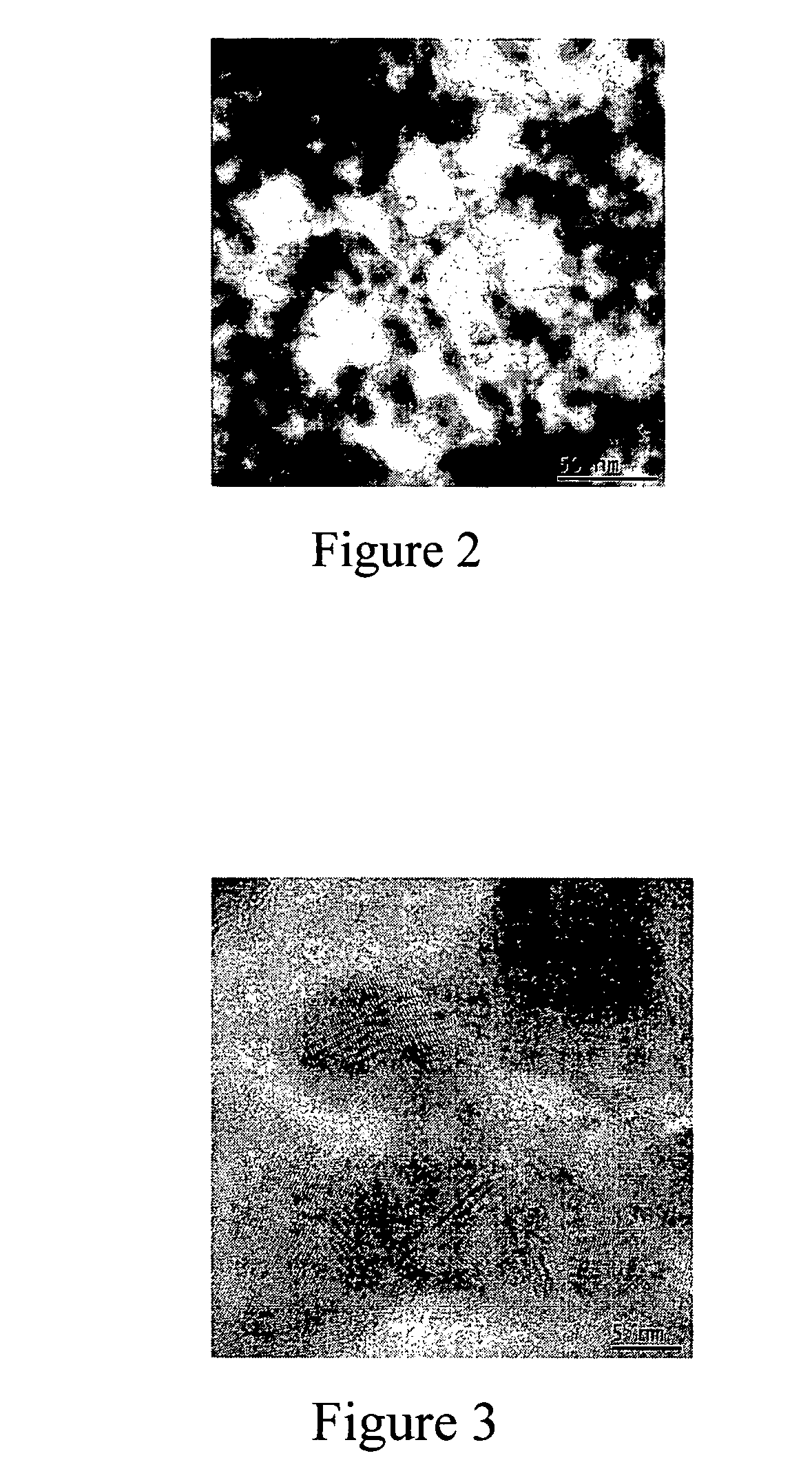Method of making nanostructured lithium iron phosphate-based powders with an olivine type structure
a lithium iron phosphate and nano-structure technology, applied in the direction of non-metal conductors, cell components, conductors, etc., can solve the problems of poor electronic conductivity of lithium metal phosphates, low cost and environmentally benign rechargeable li-ion batteries, and high power density, and achieve easy scalable processes and low cost. , good electrochemical properties
- Summary
- Abstract
- Description
- Claims
- Application Information
AI Technical Summary
Benefits of technology
Problems solved by technology
Method used
Image
Examples
example 1
Nanostructured LiFePO4
[0023]16 cc (19.93 g) of an iron dextran (Ferrodex® 100) solution was mixed with 50 cc of water. In another flask, 3.46 g of H3PO4 (85 wt %) solution was mixed with 50 cc of distilled water. The Fe-dextran solution was heated to boiling. While this solution was boiling, the H3PO4 solution was added drop wise into the hot solution. After completely adding the H3PO4 solution, 25 cc of water added to dilute the solution. In another flask, 3.06 g of lithium acetate was dissolved in 50 cc of water. The lithium acetate solution was added drop wise into the hot Fe dextran / H3PO4 solution. After completely adding the lithium acetate solution, the final solution was refluxed for 7 hrs to complete the reaction. During reluxing 100 cc of water was added to the final solution. (It is to be noted that the reaction flask was kept under the nitrogen sweep to avoid the oxidation of Fe2+ into Fe3+). After the refluxing step, the excess water was evaporated using a rotary evapora...
example 2
Nanostructured (or Ultrafine) LiFe0.4Mn0.6PO4
[0024]6.72 cc (7.972 g) of an iron dextrane (Ferrodex® 100) solution was mixed with 50 cc of water, and 3.06 g of lithium acetate was dissolved in the iron dextran solution. In another flask, 3.46 g of H3PO4 (85 wt %) solution was mixed with 25 cc of distilled water. The Fe-dextran / lithium acetate solution was heated to boiling. While this solution was boiling, the H3PO4 solution was added drop wise into the hot solution. In another flash, 4.4144 g of manganese acetate was dissolved in 45 cc of water. The manganese acetate solution was added drop wise into the hot Fe dextran / H3PO4 / lithium acetate solution, while the solution was hot. After completely adding the manganese acetate solution, the final solution was refluxed for 4 hrs to complete the reaction. (It is to be noted that the reaction flask was kept under the nitrogen sweep to avoid the oxidation of Fe2+ into Fe3+). After the refluxing step, the excess water was evaporated using a ...
example 3
Carbonization of Nano-LiFePO4 Using C2H4 Gas
[0025]0.049 g of cobalt nitrate (Co(NO3)3.6H2O) in the 20-25 cc of ethanol, and 1.0 g of nano-LiFePO4 was dispersed in the ethanol / cobalt nitrate solution. After completely adding the nanopowder, the final solution was stirred for 15-20 min before evaporating the excess ethanol. The dried powder was heat treated in pure H2 gas at 450° C. for 1 hr to coat nanoparticles with Co. Co coated nano-LiFePO4 particles were further annealed at 550° C. for 6 min. in a C2H4 / H2 ratio of 1, there was a 15 wt % carbon deposition. At the end of reaction, the total weight gain was 24%. The amount of carbon was reduced to only 14% just be reducing the C2H4 / H2 ratio from 1 to 0.5, while keeping the total flow rate constant to 200 cc / min. FIG. 6 shows the carbon deposition on a nano-LiFePO4 powder by a C2H4 / H2 gas mixture.
PUM
| Property | Measurement | Unit |
|---|---|---|
| particle size | aaaaa | aaaaa |
| particle size | aaaaa | aaaaa |
| temperature | aaaaa | aaaaa |
Abstract
Description
Claims
Application Information
 Login to View More
Login to View More - R&D
- Intellectual Property
- Life Sciences
- Materials
- Tech Scout
- Unparalleled Data Quality
- Higher Quality Content
- 60% Fewer Hallucinations
Browse by: Latest US Patents, China's latest patents, Technical Efficacy Thesaurus, Application Domain, Technology Topic, Popular Technical Reports.
© 2025 PatSnap. All rights reserved.Legal|Privacy policy|Modern Slavery Act Transparency Statement|Sitemap|About US| Contact US: help@patsnap.com



